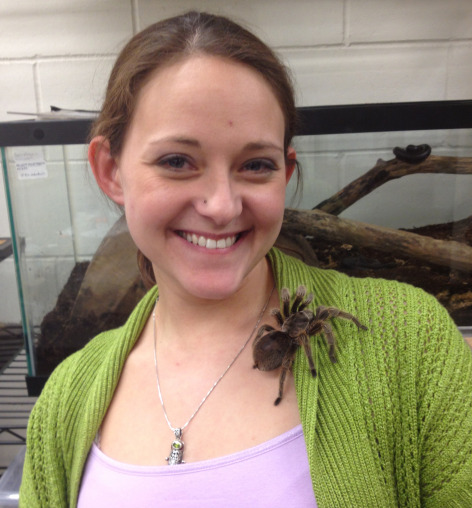
Ginny Morgal emphasizes interactivity and the scientific process since taking over the ISU Insect Zoo last May. Morgal is pictured here with a Chilean rose hair tarantula, which is part of the Insect Zoo. Photo courtesy of Ginny Morgal.
AMES, Iowa – Less than a year into her position as the program assistant in charge of the traveling Insect Zoo at Iowa State, Ginny Morgal is putting her stamp on the program.
Morgal spends several days a week packing a traveling circus that includes scorpions and tarantulas into a van and going into classrooms across the state where she teaches students about bugs – and the scientific process.
Morgal said she’s tried to bring a new level of interactivity to the Insect Zoo since she took over last May, encouraging students to take ownership of what they’re learning. For instance, rather than offering schoolchildren a rote explanation of how hissing cockroaches make the distinct sound from which they derive their name, Morgal asks students to closely observe the cockroaches for a few moments and come up with their own hypotheses about how and why the bugs make such a racket.
“When I go into a classroom, I tell the students that they’re going to be entomologists for a day,” Morgal said. “I want students to ask their own questions and then try to find their own answers. That’s the scientific process, and I think that creates a more rewarding experience.”
How roaches hiss
For those who have never seen a hissing cockroach, the sound emanates from several holes on the backside of the abdomen. The hissing is the sound of the cockroach forcefully pushing air through these holes, a defense mechanism meant to ward off predators.
Morgal said she uses the creatures in the Insect Zoo to illustrate various biological and ecological concepts to students, but she knows that the stars of her presentations are the creatures themselves. They range from roaches, beetles and mealworms to more exotic species such as scorpions, tarantulas and giant African millipedes.
She said her companions make an impression wherever they go.
“There are always students who want to keep their distance and don’t want to touch them,” she said. “But more often than not, once the class has had a chance to get used to some of them, those kids end up giving it a chance and at least touch one of the bugs.”
A former pre-school teacher who studied insect biology in college, Morgal’s new gig with the Insect Zoo is a great fit for her experience and interests. But she wasn’t always so comfortable around creepy-crawly creatures.
“I was afraid of bugs as a kid until I found out my mom hated them,” she said. “So I can relate when some kids are a little hesitant to take a closer look.”
Scheduling a classroom visit
Morgal encouraged teachers interested in having the Insect Zoo visit their classrooms to contact her or to log on to the zoo’s website at http://www.ent.iastate.edu/insectzoo/ where they can fill out a visit request form.